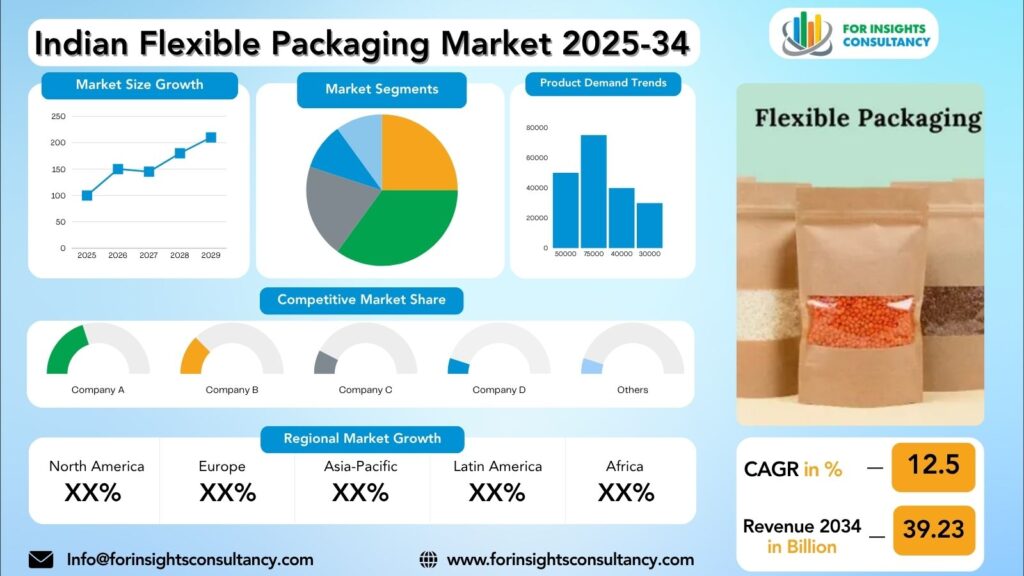
Indian Flexible Packaging Market Size, Trends Analysis Research Report By Material Type (Plastic, Paper, Aluminum Foil, Cellulosic), By Product Type (Pouches,Bags and Sacks, Wraps and Films, Laminates), And By End-User Industry (Food and Beverages, Pharmaceuticals, Personal Care and Cosmetics, Household Products, Industrial and Other Applications), And By Region Global Market Analysis And Forecast, 2025-2034
Sep-2025 Formats | PDF | Category: Packaging| Delivery: 24 to 72 Hours
Indian Flexible Packaging Market Is Forecast to Increase from USD 21.46 Billion In 2025 To USD 39.23 Billion By 2034, At A CAGR Of 12.5%.
Indian Flexible Packaging Market: A Comprehensive Overview and Future Developments
The Indian flexible packaging market has experienced significant growth and development in recent years, playing a crucial role in various industries such as food and beverage, pharmaceuticals, and personal care. The market offers flexibility, durability, and cost-effectiveness, making it a popular choice for manufacturers and consumers. The food and beverage industry is the largest consumer of flexible packaging products in India, followed by the pharmaceutical and personal care sectors. Advancements in technology have led to the development of high-barrier films, retort pouches, and stand-up pouches, providing extended shelf life and enhanced product protection.
Key trends and developments in the Indian flexible packaging market include a shift towards eco-friendly packaging, smart packaging technologies, convenience and portability, and emphasis on food safety and hygiene. Consumers are becoming more environmentally conscious, prompting manufacturers to invest in sustainable packaging solutions. Smart packaging technologies, such as RFID tags, QR codes, and interactive packaging solutions, help improve supply chain visibility, reduce counterfeiting, and enhance consumer engagement. Convenience and portability are also driving the demand for flexible packaging, with stand-up pouches, spouted pouches, and zip-lock bags offering easy opening, resealability, and on-the-go convenience.
The Indian flexible packaging market is poised for continued growth and innovation in the coming years, driven by rising consumer spending, urbanization, changing lifestyles, and evolving retail channels. Manufacturers can capitalize on these trends by investing in R&D, adopting digital printing technologies, and expanding their product portfolio. Collaboration with brand owners, retailers, and regulatory bodies is essential to meet evolving consumer expectations and regulatory requirements.
Growth Drivers
The Indian flexible packaging market has seen significant growth in recent years, driven by various factors. The market is driven by strong demand from various industries, such as food and beverage, pharmaceuticals, personal care, and household products, who are increasingly opting for flexible packaging solutions due to its cost-effectiveness, lightweight properties, and ability to extend product shelf life. The growing focus on sustainability and environmental responsibility has also driven the demand for eco-friendly and recyclable packaging solutions. Technological advancements in packaging, such as smart packaging, digital printing, and anti-counterfeiting features, have also contributed to the market’s growth.
The rising disposable income and changing consumer preferences in India have led to a greater demand for on-the-go and easily accessible products. Flexible packaging offers the convenience and portability that modern consumers seek, making it an ideal choice for companies seeking to tap into this growing market segment.
The Indian government has introduced several initiatives and policies to promote the growth of the packaging industry, including incentives for packaging innovation, investment in packaging infrastructure, and efforts to streamline regulatory processes. By creating a favorable business environment for packaging companies, the government is playing a crucial role in driving growth and attracting investments in the flexible packaging market.
Restraints
The Indian flexible packaging market has experienced significant growth in recent years due to changing consumer preferences, increasing disposable incomes, and the e-commerce sector. However, the market faces several challenges, including raw material price volatility, increasing environmental concerns, regulatory compliance, intense competition, and fluctuating currency exchange rates.
Raw material price volatility can significantly impact production costs, making it difficult for companies to plan budgets effectively and leading to unstable profit margins. The growing demand for sustainable packaging solutions has put pressure on manufacturers to develop eco-friendly alternatives, but this can be costly and require significant investments in new technology and materials.
Regulatory compliance is another challenge, as the market is subject to complex regulations and standards that can be time-consuming and expensive for small and medium-sized enterprises. Failure to comply can result in fines, lawsuits, and damage to brand reputation.
Intense competition in the market can drive down prices and profit margins, making it difficult for companies to differentiate themselves based on quality or innovation alone. To succeed, companies must continually invest in research and development to stay ahead of the curve.
Furthermore, fluctuations in currency exchange rates can significantly impact the cost of imported raw materials, affecting the overall cost of production for packaging manufacturers. This volatility can make it difficult for companies to plan pricing strategies and lead to financial risk.
Despite these challenges, there are opportunities for growth and innovation in the Indian flexible packaging market. By investing in research and development, adopting sustainable practices, and staying ahead of regulatory changes, companies can position themselves for long-term success in this dynamic market.
Opportunities
The Indian flexible packaging market is experiencing a surge in demand due to the increasing trend of on-the-go consumption and busy lifestyles. This presents a significant opportunity for flexible packaging manufacturers to cater to the needs of food companies seeking innovative and sustainable packaging solutions. The shift towards sustainable packaging is driven by environmental concerns, with flexible packaging offering the advantage of being recyclable and reducing carbon footprint.
Technological advancements, such as smart packaging solutions and digital printing techniques, are transforming the market. The booming e-commerce industry in India has also created a demand for efficient and convenient packaging solutions. Flexible packaging offers benefits like lightweight, durability, and customization options, making it an ideal choice for e-commerce companies. Consumers are also seeking unique and personalized packaging experiences, with flexible packaging allowing for easy customization, attracting more customers and building brand loyalty. By leveraging these trends, businesses can capitalize on the ever-evolving Indian flexible packaging landscape and thrive in the competitive market.
Challenges
The Indian flexible packaging market has seen significant growth in recent years due to the growing demand for convenient and sustainable packaging solutions. However, this growth has also presented challenges for companies to remain competitive and meet the evolving needs of consumers. Key challenges include rising raw material costs, changing consumer preferences, regulatory compliance, and supply chain disruptions.
Rising raw material costs, such as plastic films, adhesives, and inks, put pressure on companies to maintain profitability while delivering quality products at competitive prices. To address this, companies need to focus on innovation, efficiency, and exploring alternative materials and sourcing options.
Changing consumer preferences, such as sustainability, convenience, and visual appeal, require companies to continuously adapt their packaging solutions. This requires a deep understanding of consumer behavior and market trends, as well as a commitment to research and development.
Regulatory compliance is another key challenge for companies in the Indian flexible packaging market. Companies must ensure compliance with local and international standards for safety, quality, and environmental sustainability, often requiring significant investments in testing, certification, and compliance processes.
Supply chain disruptions, such as natural disasters, political instability, or market fluctuations, can significantly impact a company’s ability to deliver products on time and meet customer demands. To address this, companies need to develop robust supply chain management strategies, build strong partnerships with reliable suppliers, and implement contingency plans.
Indian Flexible Packaging Market Top Companies Covered In This Report:
Evaluate The Strategic Positioning And Innovation Pipelines Of Leading Market Companies-From Multinational Enterprises To Disruptive Regional Firms. Understand How Key Players Are Innovating, Expanding, And Capturing Value, And Use Competitive Benchmarks To Plan Your Next Move.
- UFlex Ltd.
- Jindal Poly Films
- Cosmo First Ltd.
- Huhtamaki India
- TCPL Packaging
- Platinum Packaging
- Visaka Industries
- Sealed Air
- Ravi Kiran Packaging
- Berry Global
- Amcor
- Smarter Packaging
- Glenroy
- Dow Chemical
- Shree Ganesh Packaging
Indian Flexible Packaging Market News
UFlex Ltd.
UFlex secured an Indian patent in July 2025 for a sustainable waterborne heat seal coating for food packaging. In early 2024, the company began commercial production of poly-condensed polyester chips in Panipat, India, showcasing a commitment to backward integration and material innovation. The company’s aseptic packaging business is a key growth area. In late 2024, UFlex announced plans to invest $126 million to set up a new aseptic packaging facility in Egypt to cater to global demand.
Jindal Poly Films
The company faced a significant setback with a fire at its Nashik plant in May 2025, which impacted its production capacity and led to a sharp decline in profits for the quarter ending June 2025.
Despite this, Jindal is moving forward with a plan to de-merge its Global Non-Woven (GnL) business to facilitate separate growth. This move, announced in August 2025, aims to unlock value by separating the two business segments. The company has also been focusing on adding higher-value products to its portfolio, such as nylon films and BOPA films.
Cosmo First Ltd.
In mid-2025, the company commissioned a new BOPP packaging manufacturing line with an investment of over ₹400 crore, significantly increasing its production capacity. Cosmo launched new products like Sunshield window film in May 2025 and introduced advanced capacitor films, a move driven by the increasing adoption of electric vehicles in India.
Huhtamaki India
In mid-2025, the company launched new compostable ice cream cups as part of its global sustainability strategy. The company also introduced a new recyclable paper cup for dairy, showcasing its commitment to reducing plastic content.
Segmented View Of The Industry:
The Equipment Segment Holds The Largest Market Share Due To The High Cost Of Terminals, Antennas, And Modems. However, The Connectivity Services Segment Is Expected To Show The Highest Growth Rate.
The Indian Flexible Packaging Market Is Mapped Through A Multidimensional Lens-Tracking Shifts Across Product Type, Applications, And Geographic Regions. This Segmented Approach Enables Businesses To Localize Their Growth Plans And Align Offerings With The Most Profitable Demand Centers.
Segmentation By Material Type
- Plastic
- Paper
- Aluminum Foil
- Cellulosic
Segmentation By Product Type
- Pouches
- Bags and Sacks
- Wraps and Films
- Laminates
Segmentation By End-User
- Food and Beverages
- Pharmaceuticals
- Personal Care and Cosmetics
- Household Products
- Industrial and Other Applications
Global Geographic Coverage:
Based On Recent Market Analysis, North America Is The Largest And Most Mature Market For Very Small Aperture Terminals (Vsat). Its Leading Position Is Driven By Significant Investments In Defense And Government Sectors And A Well-Established Telecommunications Infrastructure.
The Report Provides In-Depth Qualitative And Quantitative Data On The Indian Flexible Packaging Market For All Of The Regions And Countries Listed Below:
India
The Indian flexible packaging market is experiencing rapid growth due to the increasing demand for convenient and sustainable packaging solutions. With a population of over 1.3 billion people, India presents a lucrative market for flexible packaging manufacturers. India is the largest consumer of flexible packaging in the South Asian region, accounting for over 60% of the total market. The country’s thriving food and beverage industry, e-commerce, and government initiatives promoting sustainable packaging practices have boosted market growth.
Maharashtra is a leading state in terms of flexible packaging consumption due to its vibrant industrial sector, particularly in food processing and pharmaceutical industries. The state’s strategic location and well-established infrastructure make it a favored destination for packaging manufacturers. Gujarat is another key market for flexible packaging due to its strong manufacturing base and export-oriented industries. The state’s proactive policies to attract investments and promote entrepreneurship have attracted several flexible packaging companies to set up operations.
Tamil Nadu is emerging as a significant market for flexible packaging due to its diverse industrial landscape and growing consumer market. The state’s thriving retail sector and focus on sustainable development and eco-friendly practices have encouraged the adoption of flexible packaging among local businesses.
Reasons To Buy:
- The Research Would Help Top Administration/Policymakers/Professionals/Product Advancements/Sales Managers And Stakeholders In This Market In The Following Ways.
- The Report Provides Indian Flexible Packaging Market Revenues At The Worldwide, Regional, And Country Levels With A Complete Analysis To 2034 Permitting Companies To Analyze Their Market Share And Analyze Projections, And Find New Markets To Aim For.
- To Understand The Most Affecting Driving And Restraining Forces In The Market And Their Impact On The Global Market.
- Major Changes And Assessment In Market Dynamics And Developments.
- The Objective Of The Indian Flexible Packaging Market Report Is To Identify New Business Opportunities Using Quantitative Market Forecasts.
- Formulate Sales And Marketing Strategies By Gaining An Understanding Of Competitors, Their Positioning, And Strengths & Weaknesses.
Faq – What Global Leaders Are Asking
What Is The Growth Prospect For The Indian Flexible Packaging Market By 2034?
Indian Flexible Packaging Market Is Expected To Achieve A Stable Growth Rate With A Compound Annual Growth Rate (CAGR) Of About 12.5% From 2025 Through 2034.
What Is Driving The Growth Of The Indian Flexible Packaging Market?
The growth of the Indian flexible packaging market is driven by increasing domestic demand for packaged foods and consumer goods, fueled by a rising middle class and rapid urbanization. This trend is further accelerated by the e-commerce boom and a growing industry focus on sustainable and eco-friendly packaging solutions.
Who Are The Key Players In The Indian Flexible Packaging Market, And What Are Their Market Shares?
The Indian Flexible Packaging Market Includes Major Companies Like UFlex Ltd., Jindal Poly Films, Cosmo First Ltd., Huhtamaki India, TCPL Packaging, Platinum Packaging, Visaka Industries, Sealed Air, Ravi Kiran Packaging, Berry Global, Amcor, Smarter Packaging, Glenroy, Dow Chemical, Shree Ganesh Packaging, Others.
Specific Market Share Data Is Not Publicly Available And Is Typically Provided In Detailed, Proprietary Market Research Reports.
Which Regions Are Leading The Indian Flexible Packaging Market Growth?
Asia-Pacific region is the global leader in the flexible packaging market, with China and India as the key drivers. India’s market is experiencing its own internal growth, with a strong focus on expansion in its urban and semi-urban areas.
Customization: We Can Provide Following Things
1) On Market More Company Profiles (Competitors)
2) Data About Particular Country Or Region
3) We Will Incorporate The Same With No Additional Cost (Post Conducting Feasibility).
Any Requirement Contact Us: Https://Www.Forinsightsconsultancy.Com/Contact-Us/
Table of Contents
For TOC Contact us: https://forinsightsconsultancy.com/contact-us/







